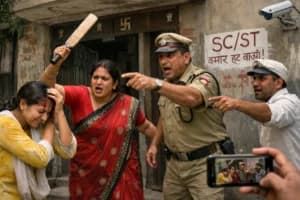The Supreme Court of India, on January 28, overturned the Bombay High Court’s judgment that upheld the death sentence awarded to Chandrabhan Sudam Sanap for the 2014 rape and murder of a 23-year-old woman. The Court ruled that the prosecution failed to establish guilt beyond a reasonable doubt, citing critical gaps in the circumstantial evidence presented.
A three-judge bench comprising Justices B.R. Gavai, Prashant Kumar Mishra, and K.V. Viswanathan concluded that the prosecution's case had “gaping holes,” making it unsafe to sustain a conviction.
Background of the Case
The case revolved around the tragic death of a young woman who was traveling to Mumbai for work. Her partially burnt and decomposed body was discovered near the Eastern Express Highway. The prosecution built its case on circumstantial evidence, alleging that Sanap kidnapped, raped, and murdered the woman before setting her body on fire.
Also Read:- Supreme Court criticized the Allahabad High Court Over Bail Denial in Religious Conversion Case
The Trial Court convicted Sanap under multiple sections of the Indian Penal Code (IPC), including:
- Section 302 (Murder) – Death penalty
- Section 364 (Kidnapping for murder) – 10 years imprisonment
- Section 366 (Abduction with intent to compel marriage) – 10 years imprisonment
- Section 376(2)(m) (Aggravated rape) – 10 years imprisonment
- Section 376A (Rape leading to death) – Life imprisonment
- Section 392 read with 397 (Robbery with deadly weapon) – 7 years imprisonment
- Section 201 (Destruction of evidence) – 7 years imprisonment
Additionally, Sanap was ordered to pay ₹50,000 as compensation to the victim’s parents.
Supreme Court's Observations
Flaws in Prosecution’s Case
The Supreme Court carefully examined the 14 circumstantial pieces of evidence presented by the High Court and found severe inconsistencies in key aspects of the case, particularly in the last-seen theory, the reliability of witness testimonies, and the forensic evidence.
1. CCTV Footage Inadmissibility
A major flaw in the prosecution’s case was the reliance on CCTV footage to establish that the victim was last seen with the accused. The Supreme Court ruled that the footage could not be used as evidence because it lacked the mandatory Section 65-B(4) certificate under the Indian Evidence Act.
"When the prosecution was aware of the need for the 65-B(4) certificate and had collected it for the Call Data Records (CDRs), there was no reason why they did not obtain it for the CCTV footage."
2. Weak Last-Seen Evidence
The prosecution’s last-seen theory was based on two witnesses (PW-20 and PW-21) who claimed they saw the victim and the accused together. However, their statements were recorded two and a half months after the incident, and no explanation for the delay was provided.
"The law on circumstantial evidence mandates that any other hypothesis must be ruled out. This is not a case where conviction could be sustained even if we believe the last-seen witnesses."
Also Read:- RG Kar Rape and Murder Case: Sanjay Roy Sentenced to Life Imprisonment
3. Unreliable Witness Testimonies
The Supreme Court found that multiple witness testimonies were either inconsistent or lacked credibility. For instance, an astrologer (PW-17) claimed the accused visited him to “wash off his sins,” but the police failed to produce any systematic record to support this claim.
"We are at a loss to understand what the prosecution seeks to establish. The priest has no systematic account, and his statement does not form a reliable link in the chain of evidence."
4. Extrajudicial Confession Found Unreliable
The prosecution relied on an extrajudicial confession made by the accused to PW-9. However, the Court found that PW-9 had links with the police, raising doubts about the authenticity of the confession.
"Extra-judicial confession is a weak piece of evidence. There is no corroboration in material particulars, and we do not find it prudent to sustain the conviction based on it."
5. Forensic Evidence Did Not Prove Rape
The forensic report mentioned injuries in the genital area but did not confirm sexual assault. Moreover, no semen was found on the victim’s body or clothing. The prosecution later suggested that the injuries could have been caused by the forcible entry of an object, but this theory was introduced seven months after the post-mortem.
The final medical report states that injuries could be due to decomposition. There is no scientific basis to conclude that rape occurred beyond reasonable doubt."
6. Unreliable Recovery of Trolley Bag
The Supreme Court rejected the prosecution’s claim that the victim’s trolley bag was recovered at the accused’s instance. The witness who allegedly received the bag could not even remember who gave it to her.
"The recovery witness was unable to identify who handed over the bag, making it unreliable as evidence."
Also Read:- Calcutta High Court Reviews Appeals for Death Sentence in RG Kar Hospital Rape and Murder Case
Final Verdict: Acquittal Due to Insufficient Evidence
After analyzing all aspects of the case, the Supreme Court ruled that the prosecution failed to establish a conclusive chain of circumstantial evidence. Citing the landmark judgment Sharad Birdhichand Sarda vs. State of Maharashtra (1984), the Court reaffirmed that:
- Circumstances must be fully established.
- Facts should be consistent only with the accused's guilt.
- The evidence must exclude any possibility of innocence.
- There should be no reasonable doubt left in the case.
"The prosecution has not established its case beyond reasonable doubt. Hence, we are constrained to come to the sole irresistible conclusion that the appellant is not guilty of the offences for which he has been charged."
Also Read:- Kolkata Court Declares Sanjoy Roy Guilty in RG Kar Rape-Murder Case
This judgment highlights the importance of ensuring rigorous legal standards in criminal trials, especially when the death penalty is involved. The Supreme Court’s ruling underscores that mere circumstantial evidence is insufficient unless it forms a conclusive and unbroken chain leading to the accused’s guilt.
The acquittal of Chandrabhan Sudam Sanap serves as a reminder that justice must be based on solid evidence, not on presumptions or procedural lapses.














